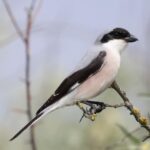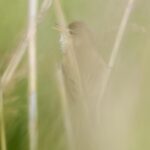A Summer Tour today, to look for Birds of Prey in the morning and head up to the coast for some more general birding in the afternoon.
We started by heading inland, meandering through the farmland behind the coast. We hadn’t gone very far when we spotted our first Red Kite drifting over the road. We pulled in at a convenient spot and watched as it circled right overhead. It was a very tatty individual – very often this is down to wear and moult, but this bird had some interesting looking holes in some of its feathers! When we scanned the skies around us, we could see several Common Buzzards starting to circle up as well.
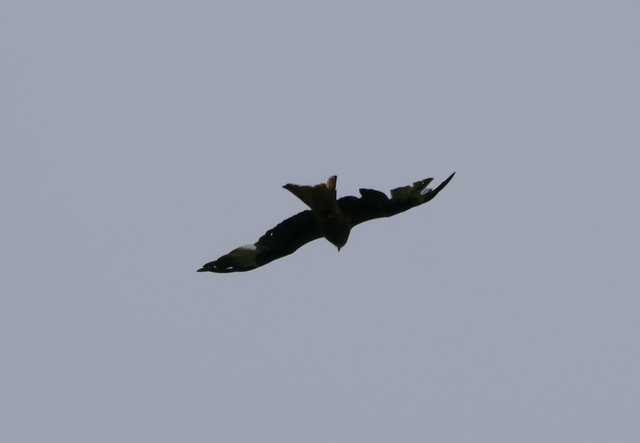 Red Kite – a very tatty bird drifted over the road
Red Kite – a very tatty bird drifted over the road
We continued on our way, and our next unscheduled stop was to admire a Little Owl perched in a gnarled old tree by the road. It eyed us warily at first, but seemed happy as long as we remained at a discrete distance in the car.
 Little Owl – watching us from an oak tree, watching it from the car
Little Owl – watching us from an oak tree, watching it from the car
It seemed to be a morning for owls, probably because they have young to feed and that forces them to hunt during daylight hours at times (there aren’t so many daylight hours either, as we approach the shortest day). Further on, we came across a Barn Owl hunting along the verge of the road, which disappeared over the hedge as it finally saw us in front of it. Then we spotted yet another Little Owl, this time perched on an old barn, sunning itself. It seemed a bit more wary, and flew off when we stopped.
Having enjoyed some great birds on our drive, our first walk of the day took us along an overgrown farm track. Several warblers were still singing from the high hedges – Blackcaps, Whitethroats, Chiffchaffs and even a couple of Willow Warblers. We could also hear the plaintive piping of Bullfinches calling from the bushes. There were lots of Yellowhammers singing too, though they were hard to see from down in the lane. As we got out into more open fields, we could see them more easily, flying back and forth.
From up on the high ground, there was a good selection of raptors on view – lots more Common Buzzards, particularly as the sun came out briefly and the temperature lifted accordingly. A Sparrowhawk circled up out of the wood. Several Common Kestrels flew back and forth.
 Common Buzzard – we saw lots circling up this morning
Common Buzzard – we saw lots circling up this morning
We saw several butterflies along the track too, particularly large numbers of Speckled Wood. A single Painted Lady was resting on a bare patch of ground – there have been lots of these migrant butterflies around in recent days. We also had to watch where we walked, to avoid stepping on the large number of Bloody-nosed Beetles walking on the track. A Brown Hare surprised a Red-legged Partridge and gave itself a bit of a shock.
We headed back to the car and drove back the way we had come. The Little Owl was back on the old barn again. This time it less us pull up alongside it, perching for a time on an old window frame, looking at us nervously, before flying off inside. Quite a haul of owls for the morning!
 Little Owl – our second of the morning, on an old barn
Little Owl – our second of the morning, on an old barn
We moved on to another site, where we parked with a good view of the surrounding countryside. There were lots of Linnets perching on the overhead wires and dropping to feed on the ground below. A Mistle Thrush perched up as well. A Lesser Whitethroat appeared in the hedge right beside the car, feeding unobtrusively deep in the bushes but occasionally working its way to the outside briefly. As we parked, we flushed a pair of Grey Partridge from close by, which disappeared into the long grass. We could hear another pair calling from the field, further over.
Several Marsh Harriers quartered the fields or circled overhead. One in particularly suddenly swooped down to some thickish vegetation and two Grey Partridge leapt out. Whether there were young birds in there we couldn’t see, but the Marsh Harrier stooped at the ground a couple of times, with the partridges seemingly defending it or themselves. The Marsh Harrier then landed on the ground nearby and a hen Pheasant appeared from the undergrowth as well. The Pheasant stared at the harrier in a stand-off for a minute or two before the Marsh Harrier finally flew off.
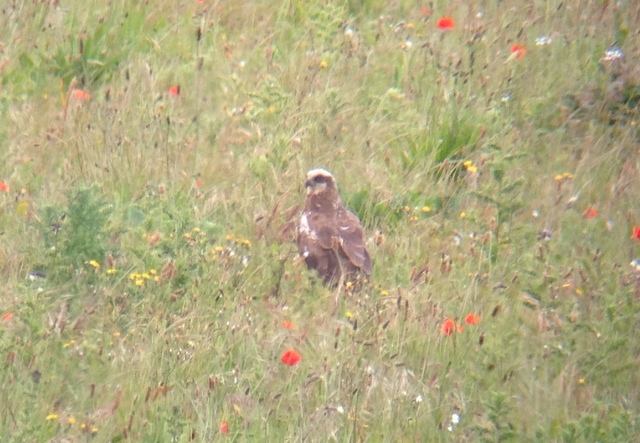 Marsh Harrier – landed on the ground after a altercation with some partridges
Marsh Harrier – landed on the ground after a altercation with some partridges
We had hoped to find Turtle Doves here, but the area of dense, overgrown hedges which they traditionally favour has recently been burnt (by the farmer burning some old straw bales). We did see a couple of Turtle Doves which flew past, but they didn’t stop and not all the group got onto them.
From there we drove down to Cley, and spent the afternoon on the reserve. Even from the Visitor Centre we could see several large shapes out on Simmond’s Scrape. From Dauke’s Hide we could see they were Spoonbills and doing what Spoonbills like to do most – sleeping! A closer look through the scope confirmed that there were three whiter juveniles and one buffier-coloured adult. We could also see the shorter, fleshy bills of the juveniles and the yellow-tipped bill of the adult when they occasionally stirred.
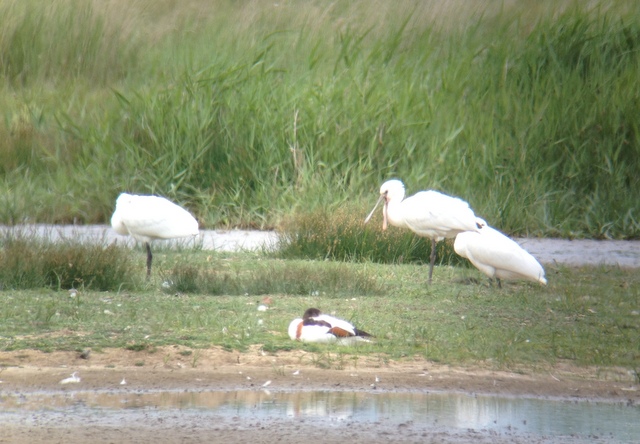 Spoonbills – three short-billed, whiter juveniles
Spoonbills – three short-billed, whiter juveniles
A little later, another adult Spoonbill flew in and dropped down onto the scrape. One of the juveniles immediately awoke and set off towards it. It started bouncing its head up and down and raising its wings as it did so. It pursued the adult backwards and forwards across the scrape in this fashion, relentlessly. The poor adult had no chance. Eventually it gave in and fed the youngster, opening its bill and regurgitating food into the juvenile Spoonbills bill.
 Spoonbills – this adult was pursued relentlessly by the juvenile to be fed
Spoonbills – this adult was pursued relentlessly by the juvenile to be fed
There were other things to see on the scrapes as well. Lots of Little Gulls today, at least 6 on Pat’s Pool, again all were 1st summer birds. Some were paler headed than others, the birds differing in the degree to which they had acquired the black hood of summer adults.

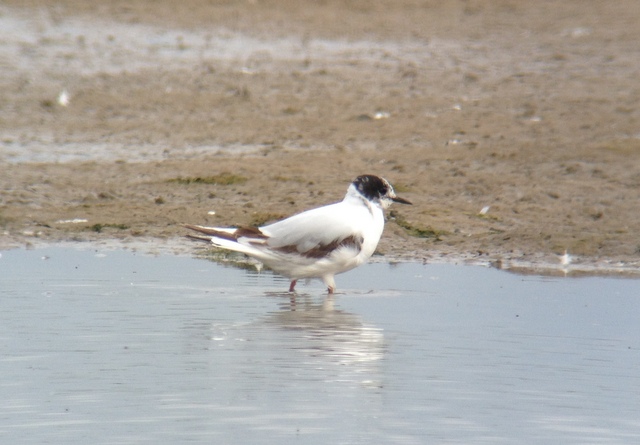 Little Gulls – six 1st summers at Cley today, with differing amounts of black
Little Gulls – six 1st summers at Cley today, with differing amounts of black
There was also a good selection of waders on show. Lots of Avocets, many still on the nest. About 30 Black-tailed Godwits dropped in. Several Little Ringed Plovers tried to hide on the islands. But the highlight was two Greenshank which flew in, one in summer plumage with dark streaking around the head and breast, and the other much paler.
We headed out to the East Bank next. There were a couple of Little Egrets along the pools by the path, and several Grey Herons as well, both adults and grey-headed juveniles. Out on the flooded grazing marsh, there were plenty of Redshanks and Lapwings, the latter in particular chasing off anything and everything that moved. There were Avocets too – they were most vocal when a 1st summer Great Black-backed Gull flew overhead, and they rose up and attempted to chase it away. A flock of Black-tailed Godwits was dozing on the bank of the Serpentine and more were out on the pools further over. There were not so many ducks as in recent weeks, but we did find a few Teal and a little group of Tufted Duck, all asleep in the grass.
Out at Arnold’s Marsh, we could see lots of terns out on the islands. A large group of Sandwich Terns were loafing. A single Little Tern was asleep and another was fishing, hovering over the main drainage channel. There were a few waders as well. In particular a good flock of almost 30 Knot – they were in grey winter-type plumage (probably 1st summer birds), so not living up to their proper name of ‘Red Knot‘. There were also three Bar-tailed Godwit hiding amongst the islands – it was interesting to compare them with the Black-tailed Godwits we had just seen. Waders are on the move already and while we were standing there we could hear Curlew calling. A flock of 13 Curlew flew west over our heads together with a moulting adult Bar-tailed Godwit. Is this a sign that autumn is coming?
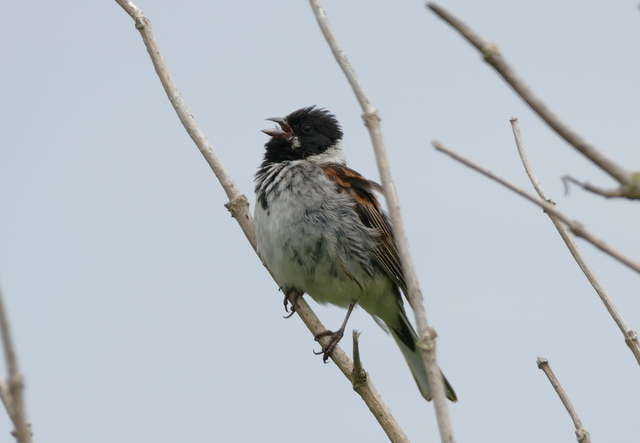 Reed Bunting – lots were still singing around the reedbeds today
Reed Bunting – lots were still singing around the reedbeds today
We got good views of the main small reedbed dwellers as we walked round – Reed Warbler, Sedge Warbler and Reed Bunting. But what we really wanted to see was a Bearded Tit. We could hear them calling as we walked out and while we looked through all the waders and terns, but we didn’t manage to get a good look at one. Only as we turned to head back did a Bearded Tit fly up out of the main reedbed and it carried on over the East Bank in front of us and dropped down into the reedy ditch on the other side. That was good, but we thought this was our chance to see it really well, so we waited for it to reappear. Needless to say, there was no sign of it. It was only when we had given up that it popped up and sat in the tops of the reeds behind us – we turned around and saw it perched there, a very smart moustachioed male Bearded Tit.
That seemed like a good way to finish, so we headed back to the car. As we walked back by the road, a juvenile Spoonbill flew over from the reserve and seemed to drop down towards the Serpentine. Then an adult appeared in the sky as well, but it dropped down onto the pools in front of us where it stopped to have a drink. We had a good look at it close up, before it took off again and it too headed for the Serpentine.
 Spoonbill – dropped in for a quick drink…
Spoonbill – dropped in for a quick drink…
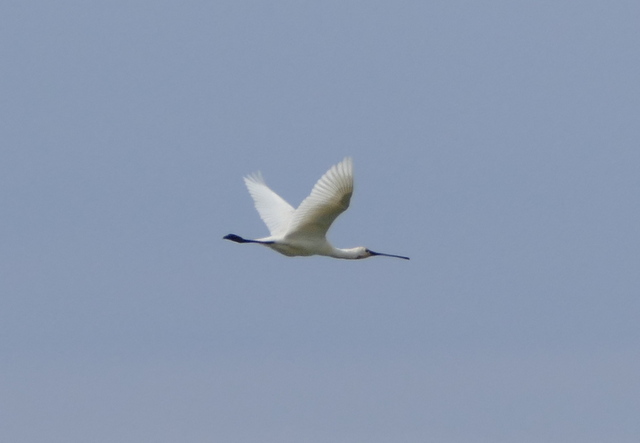 …then flew off towards the Serpentine to feed
…then flew off towards the Serpentine to feed
Nightjar Evening
After a break to rest and get something to eat, we met up again in the evening to go out and look for owls and nightjars. We had pretty much avoided any rain in the day, despite a slightly gloomy forecast, but as we arrived later on the light drizzle started. It seemed inauspicious for owls.
We drove round some regular Barn Owl locations, but there seemed to be no sign of any tonight. We stopped to listen to a Song Thrush singing from the trees. The rain was only very light, so we decided to walk out anyway onto the marshes. It was a good job we did.
We had not gone very far when we spotted our first Barn Owl, a male out hunting. Shortly afterwards, a second bird appeared much closer, a female this time. We watched them silently quartering the grazing marshes. The male dropped into the grass and came up with a vole, and he proceeded to fly back to a nest box with it and present it to presumably some juveniles inside. A further one or two birds appeared from behind us – presumably this is rich hunting territory, pulling in birds from around the area. We were treated to a great display of Barn Owls out hunting.
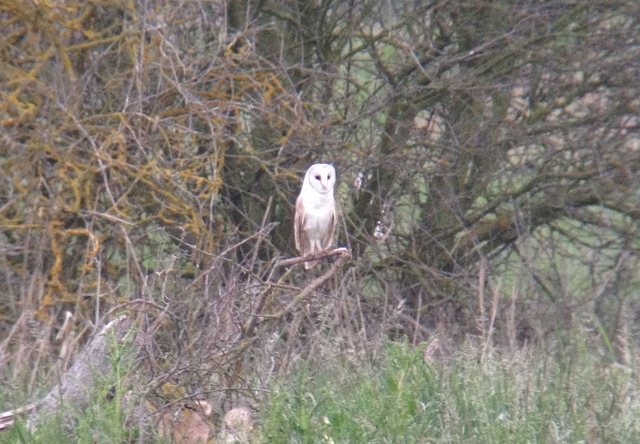 Barn Owl – one of at least 3-4 out hunting this evening
Barn Owl – one of at least 3-4 out hunting this evening
The local Marsh Harriers were also still out quartering the marshes. And while we watched them and the owls, we picked up at least three individual Spoonbills flying along the coast, presumably heading off to roost.
It would normally have still been a bit early to go looking for Nightjars, but the dull conditions meant it was darker than it would normally have been, so we decided to head up to the Heath anyway. Lucky that we did. As we walked out across the heath, we bumped into one of the locals who had located a male Nightjar roosting in a tree. We walked over to it and had great views of him in the scope before it even started to get properly dark. Stunning! After a while, still before any Nightjars would normally be awake, he headed off to another perch further over to start churring.
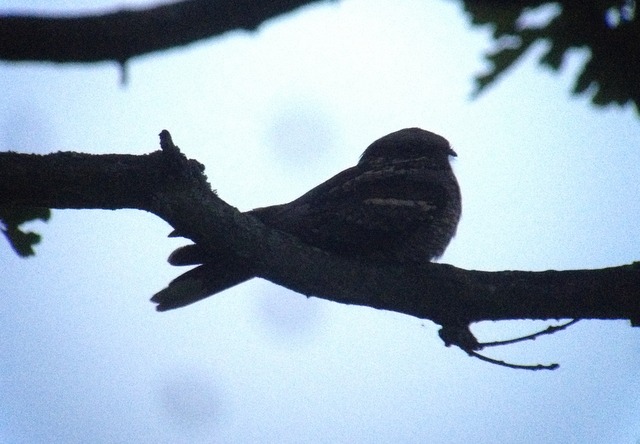 Nightjar – great views of a bird early on this evening
Nightjar – great views of a bird early on this evening
There were also Woodcock roding overhead pretty much constantly, making their distinctive squeaky flight call and we could even hear the quieter grunting as they passed low overhead. Then the male Nightjar returned to where he had been roosting and sat back down on the branch. Shortly afterwards, a second male Nightjar started churring nearby. This prompted the first male to respond, and he flew back in close to us, calling and displaying with the distinctive flicking wing action. He flew round above us several times. As the gloom descended, what was presumably a female flew in as well.
It was an all-action Nightjar evening, with great views of the birds despite what seemed initially like very inopportune weather conditions. Then it was time to retire to bed – happy.
